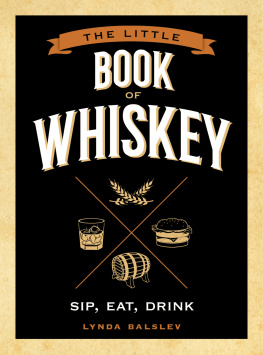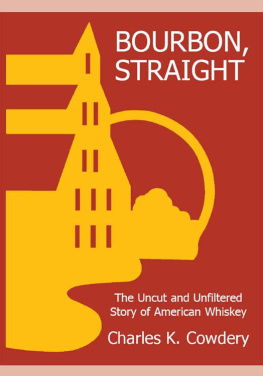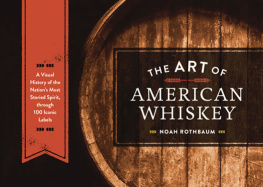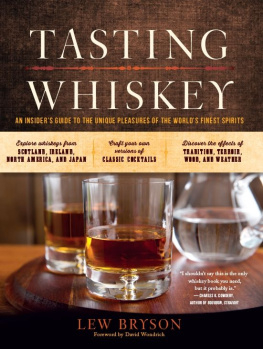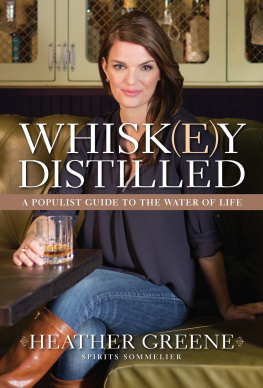WHISKEY WOMEN
W HISKEY W OMEN
The Untold Story of How Women Saved Bourbon, Scotch, and Irish Whiskey
FRED MINNICK

2013 by the Board of Regents of the University of Nebraska. All rights reserved. Potomac Books is an imprint of the University of Nebraska Press. Manufactured in the United States of America.
Library of Congress Cataloging-in-Publication Data
Minnick, Fred, 1978
Whiskey women: the untold story of how women saved bourbon, Scotch, and Irish whiskey / Fred Minnick.
pages cm
Includes bibliographical references and index.
ISBN 978-1-61234-564-2 (cloth: alk. paper); 978-0-61234-565-9 (pdf). 1. Whiskey industryHistory. 2. WhiskeyHistory. 3. DistillersHistory. 4. BusinesswomenHistory. 5. WomenHistory.
I. Title.
HD9395.A2M56 2013
338.4766352082dc23 2013024346
Set in Lyon Text by Laura Wellington.
Designed by A. Shahan.
To Jaclyn, my favorite whiskey woman
CONTENTS
ILLUSTRATIONS
Following page 74
A NOTE TO READERS
As you flip through these pages, you will see that I speak of both whiskey and whisky. Allow me to explain: whisky is the Scotch and Canadian spelling, while whiskey is the American and Irish spelling. I tried to respect these geographical indicators, because the proper spelling is important to whiskey drinkers. When generally referencing the spirits category, I used whiskey. Cheers!
INTRODUCTION
Although the evening was slightly cold, the sunset glowed over the blooming tulips and lush bluegrass on the grounds of the Kentucky Governors Mansion. April showers had been kind, giving every plant vibrant life. Women dressed in their finest Derby attire strolled through the ornate grounds to the mansions steps, under thick Southern columns. Two women stood at the doorway, looking out at Kentuckys First Garden, taking in the moment, knowing the significance of this day, April 14, 2011. The women were the founding members of the first American female drinking club to publicly kick off in a states governors mansion. The new organization, Bourbon Women, sought to take back something they had losta ladys rightful place in whiskey history. And of course, they did this while sipping Manhattans and whiskey on the rocks with the First Lady of Kentucky, Jane Beshear.
We, ladies, love our bourbon, and were here to show the world its not just a mans drink, said the founder, Peggy Noe Stevens, who was a master taster for the spirits company Brown-Forman. Informal female whiskey clubs exist all over the world, but this was the first organization with national intentions to be created. Politicians, spirit brand executives, authors, and James Beardnominated chefs joined the soiree to rub elbows with Mrs. Beshear, leaving one to ask an obvious question: What kind of drinking club launches in its states governors mansion with the First Lady as a founding member?
Women have always been a part of the bourbon business, and its a big part of our states economy, Beshear said. Since 95 percent of bourbon, a form of American whiskey made mostly from corn, is made in Kentucky, theres strong state political capital behind this female club. Yet the notion of women and whiskey goes beyond the happenings of this small state. In boardrooms from France to New York, brand managers are discussing how to make a predominantly male-centric product more appealing to women. Whiskey, the Irish and American spelling, and whisky, the Scotch and Canadian spelling, have never taken such a strong stance toward women. According to a 2012 Simons Market Research report, women represent 30 percent of the total whiskey-drinking population. Large publicly traded companies hope to increase this female demand.
Bottles and labels are becoming more feminine and elegant, while flavored whiskey targets female consumers in much the same way as flavored vodkas. Perhaps the greatest tribute to the growth of women and distilled malts is the fact the Glenfiddichs Janet Sheed Roberts Reserve, a fifty-five-year-old single malt Scotch named after the founders granddaughter, sold for $94,000 at auction in 2012. Although other whiskies have sold for more, Glenfiddichs extremely limited edition (only eleven bottles were made) is one of the highest-selling all-time whiskies. The Reserve sold just two weeks before Sheed Roberts passed away at age 110.
Whiskey was once the ladys staple beverage for guests. In the 1700s and 1800s, Scottish and American women mixed whiskey with tea and sugar in punch bowls, while Irish women used poitn, Irish moonshine, to keep their families healthy. They continued enjoying whiskey during Prohibition and up until the late 1950s. But a womans whiskey-drinking habits of yesterday are not why I pursued this book. Something Stevens said at the Bourbon Women founding meeting stuck with me: Women were the first distillers.
First Lady Beshear explained the contributions of women: Women have been involved with bourbon for many, many years. If you look back, you would see so many women in all parts of the business, from the actual preparation to the bottling to working on the Board of Directors. If women have been so important to whiskey, why are we just now talking about them? Flip through any magazine covering whiskey over the past fifty years, and youll see drastically more coverage of men than women. When women are used in whiskey brand promotions, they are sexually objectified to allure potential male drinkers with their short skirts, long legs, and busts. In addition, whiskey is almost exclusively named after men.
For a business steeped in tradition and history, whiskey has forgotten its better half. Women have always been a part of whiskey history; theyve just never received credit. As I pursued the story of womens role in the whiskey industry, I discovered that women contributed greatly to the evolution of alcohol.
Nearly four thousand years before whiskey was first distilled, Sumerian women invented beer. An Egyptian woman created the alembic still around 3 AD , giving moonshiners an early prototype for the stills they use today. Medieval European women worked in apothecaries, distilling everything from rosewater to potatoes. They called these early distillations aqua vitae (Latin) and Usque-, Uisce-, or Uisge-Beatha (Gaelic), both meaning water of life. Although the word whiskey had been used in the 1500s, it did not become a common term until the 1800s. Even some mid-nineteenth-century American accounts show that rum, tequila, and brandy were frequently mistaken for whiskey. This categorical confusion may explain why early female distillers are often left out of whiskey history; they were distilling anything and everything before whiskey became a popular term. But their contributions should not be overlooked. This book explains how 1600s Scottish aqua vitae makers were accused of witchcraft and why 1800s Irish tax collectors targeted female whiskey makers.
Whether they were beaten down by their respective governments or they simply chose to conform to their expected societal roles, women liquor makers became fewer as distilling became big business. They typically only owned distilleries after their husbands died. In Ireland and Scotland, more than thirty women owned legitimate tax-paying distilleries. Some women drove their companies into the ground; others planted the seeds for future whiskey empires. From the 1700s to the 1950s, these women distillery owners were among the most influential people in the entire spirits industry. Laphroaig, Dalmore, Bushmills, and Johnnie Walker might not be here today without a woman owner in the brands history.
Next page

